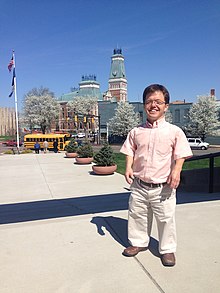User:Mr. Ibrahem/Dwarfism
| Dwarfism | |
|---|---|
| Other names | Restricted growth, dwarf, little person (LP), person of short stature |
 | |
| A man in Columbus, Indiana, with dwarfism caused by achondroplasia | |
| Pronunciation | |
| Specialty | Endocrinology, medical genetics |
| Types | Proportionate, disproportionate[1] |
| Causes | Short parents, growth hormone deficiency, genetic disorders[1] |
| Diagnostic method | Height < 147 centimetres (4 ft 10 in)[2] |
| Treatment | Based on the cause[3] |
| Medication | Growth hormone therapy[3] |
| Prognosis | Generally normal life expectancy[2] |
| Frequency | ~2.5% (USA)[4] |
Dwarfism is when an person is exceptionally short.[1] This is sometimes defined as an adult height of less than 147 centimetres (4 ft 10 in).[2] There are two main types: disproportionate dwarfism with short limbs and proportionate dwarfism with both short limbs and torso.[1] Intelligence is usually normal, as is life expectancy.[2] Other symptoms may depend on the underlying cause.[5]
The most common cause of proportionate dwarfism is having short parents; though it may also occur due to growth hormone deficiency, Turner syndrome, and other genetic conditions.[1] Disproportionate dwarfism is most commonly due to achondroplasia.[1] More than 300 conditions can result in dwarfism.[2] Diagnosis may occur before, at, or some time after birth.[1]
Treatment depends on the underlying cause.[3] Those with growth hormone deficiency and certain other conditions may be treated with growth hormone therapy.[3] In cases with particularly short legs, surgery to lengthen them may be carried out, though this is generally not recommended.[3][4] Other measures may include physiotherapy and modification of the persons environment.[3][6] Women with disproportionate disease who become pregnant generally require cesarean delivery.[7]
Dwarfism affects about 2.5% of people in the United States.[4] Most people prefer the use of their name; though terms such as "little person" (LP), "person of short stature", or "dwarf" may be used.[8] Historically, the term "midget" was used; however, this term is now often regarded as offensive.[9][7] Those affected may face height discrimination and bullying.[7] Support groups may provide services and resources.[10]
References[edit]
- ^ a b c d e f g "Restricted growth (dwarfism)". nhs.uk. 23 October 2017. Archived from the original on 14 December 2021. Retrieved 8 February 2022.
- ^ a b c d e "MedlinePlus: Dwarfism". MedlinePlus. National Institute of Health. 2008-08-04. Archived from the original on 2015-09-05. Retrieved 2008-10-03.
- ^ a b c d e f "Restricted growth (dwarfism) - Treatment". nhs.uk. 21 February 2018. Archived from the original on 11 September 2021. Retrieved 8 February 2022.
- ^ a b c Jain, Megha; Saber, Ahmed Y. (2022). "Dwarfism". StatPearls. StatPearls Publishing. Archived from the original on 11 October 2021. Retrieved 8 February 2022.
- ^ "Restricted growth (dwarfism) - Symptoms". nhs.uk. 21 February 2018. Archived from the original on 16 August 2021. Retrieved 8 February 2022.
- ^ "A Guide To Home Modifications". www.lpaonline.org. Archived from the original on 7 October 2021. Retrieved 8 February 2022.
- ^ a b c "Dwarfism - Symptoms and causes". Mayo Clinic. Archived from the original on 12 December 2013. Retrieved 8 February 2022.
- ^ "FAQ". www.lpaonline.org. Archived from the original on 4 February 2022. Retrieved 8 February 2022.
- ^ "Definition of MIDGET". Merriam-webster.com. Archived from the original on 2017-11-14. Retrieved 2022-01-26.
- ^ "Dwarfism - Diagnosis and treatment - Mayo Clinic". www.mayoclinic.org. Archived from the original on 9 May 2021. Retrieved 8 February 2022.
